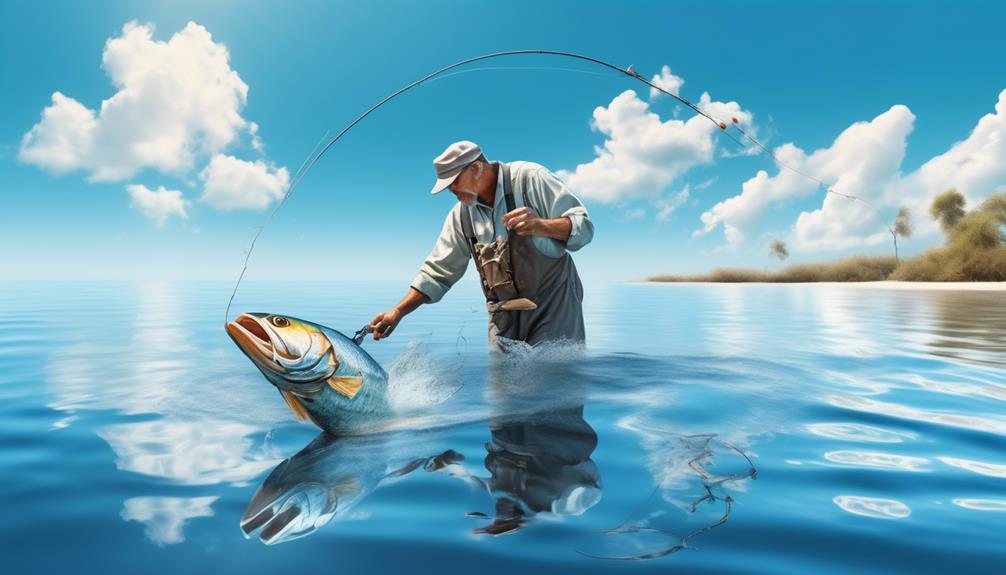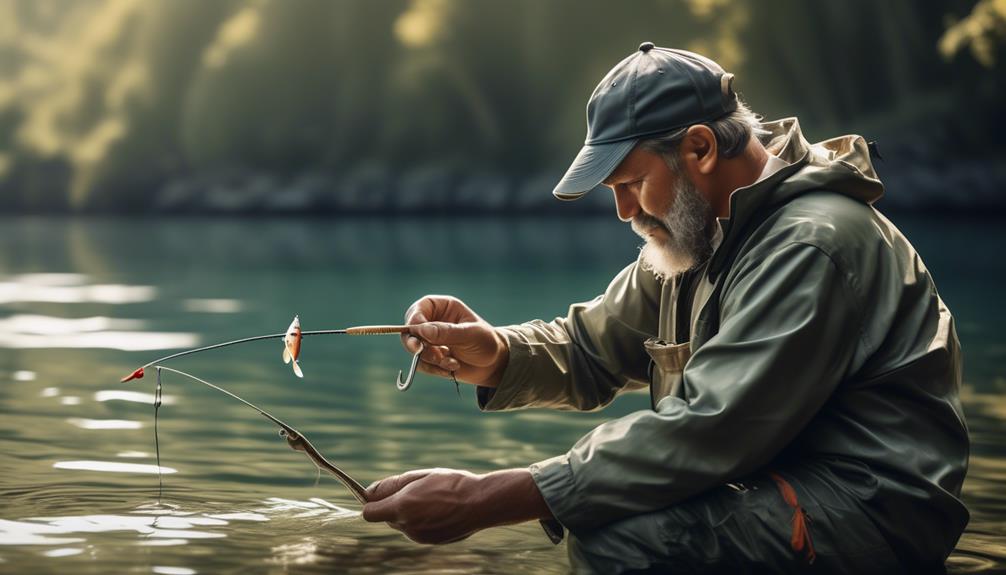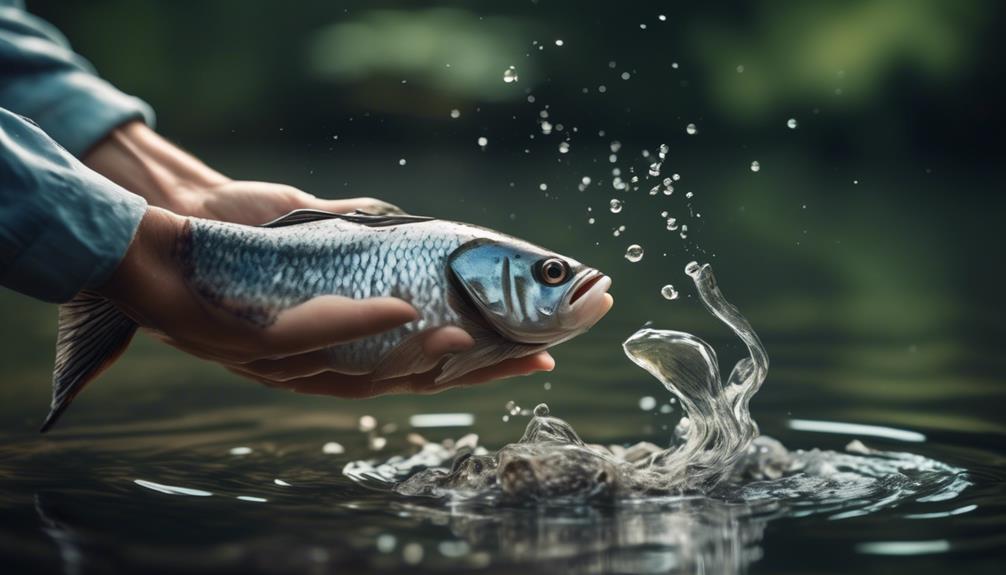You may be surprised to learn that approximately 70% of anglers practice catch and release when fishing. While this is a commendable effort to conserve fish populations, simply releasing a fish back into the water doesn't guarantee its survival.
There are several effective techniques that can greatly increase a fish's chances of survival after being caught and released. These techniques not only benefit the fish but also contribute to the sustainability of the sport. By implementing these methods, you can ensure that the fish you release have the best chance of thriving.
Proper Handling of the Fish
When handling the fish, gently support its body to avoid causing unnecessary stress or injury. Ethical fishing practices prioritize the well-being of the fish even during catch and release. By minimizing stress and injury, you can ensure the fish has the best chance of survival after being released back into the water.
To reduce fish stress, avoid removing the fish from the water whenever possible. If you need to handle the fish, wet your hands first to prevent damaging the protective mucus layer on the fish's skin. Additionally, try to keep the fish in the water while removing the hook, using tools like forceps or de-hooking devices to minimize handling time.
When lifting the fish, support its body properly rather than dangling it by the line, which can cause injury and stress. Cradle the fish gently and avoid bending its body unnaturally. If you need to take a photo, keep the fish close to the water, and quickly return it once the photo is taken.
Lastly, be mindful of the fish's recovery. After handling the fish, place it back in the water, and hold it gently until it swims away on its own. Avoid releasing the fish into strong currents or areas with predators, as it may still be disoriented from the experience.
Use of Barbless Hooks
To ensure the well-being of the fish during catch and release, it's important to consider using barbless hooks to minimize injury and facilitate easier hook removal. Barbless hooks are designed with a smooth, rounded hook point, lacking the traditional barb that protrudes backwards. This design significantly reduces the damage caused to the fish's mouth, making it easier to release them back into the water unharmed. When a fish is hooked with a barbless hook, the absence of the barb allows for a quicker and gentler hook removal process, minimizing stress and injury to the fish.
Using barbless hooks aligns with the principles of fish conservation. The reduced damage to the fish's mouth and the ease of hook removal contribute to the overall well-being of the fish population. By minimizing injury and stress during the catch and release process, anglers can help maintain healthy fish stocks in natural habitats. Additionally, barbless hooks are beneficial for sustainable fishing practices, as they support the conservation of fish populations for future generations.
Incorporating barbless hooks into your fishing gear can be a simple yet effective way to contribute to fish conservation efforts. By choosing barbless hooks, you not only prioritize the welfare of the fish but also actively participate in sustainable fishing practices. Making this small adjustment to your hook design can have a positive impact on fish populations and their ecosystems.
Minimizing Fight Time
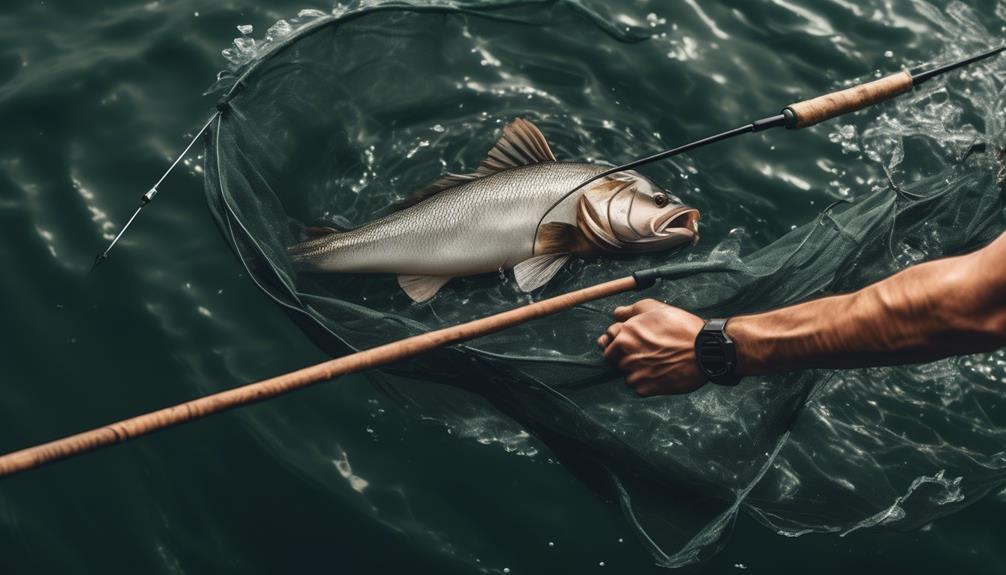
Consider using techniques to minimize the fight time when catching fish to reduce stress and exhaustion. By doing so, you can practice ethical angling and ensure the well-being of the fish you catch.
Here are some effective techniques for minimizing fight time:
- Lighter Tackle: Opt for lighter fishing gear to decrease the time it takes to reel in a fish. Lighter tackle puts less pressure on the fish, allowing you to bring it in more quickly and with less exertion on its part. Imagine using a delicate rod and line that give the fish a better chance of a swift and less stressful retrieval.
- *Visualize*: Envision using a light, flexible fishing rod that bends gracefully as you work to bring in the fish. Picture the smooth, effortless motion as the fish is reeled in, reducing its fight time and minimizing stress.
- Proper Hook Set: Master the art of setting the hook swiftly and efficiently. A proper hook set ensures that the fish is securely hooked from the start, reducing the need for a prolonged struggle. Envision a seamless hook set that swiftly and securely connects with the fish, minimizing the time it spends fighting against the line.
Quick and Safe Hook Removal
Use caution and a gentle touch to quickly and safely remove the hook from the fish's mouth.
Minimizing stress on the fish during hook removal is crucial for its well-being after release. Start by wetting your hands before handling the fish to ensure the slime layer that protects its skin isn't compromised. This will minimize stress and the risk of infection.
Next, firmly hold the fish, keeping it in an upright position to support its weight. Use long-nose pliers to grasp the hook as close to the fish's mouth as possible. With a steady hand, gently and swiftly back the hook out in the same direction it entered. Avoid twisting or forcing the hook, as this can cause further injury.
If the fish is hooked deeply or the barb is difficult to remove, consider cutting the hook with wire cutters to free the fish quickly. Always ensure you release the fish with minimal handling and in an area with good water flow to aid its quick recovery.
Adequate Revival Time
When reviving a fish after catch and release, gently hold it in the water, allowing it to regain its strength before swimming away. Proper revival techniques are crucial in ensuring the fish has the best chance of survival post-release. Conservation efforts rely on anglers to responsibly handle and release fish, minimizing the environmental impact of their sport.
Adequate Revival Time:
- Hold the fish upright in the water: Supporting the fish in an upright position helps water flow through its gills, aiding in oxygen exchange and allowing it to recover from the stress of being caught.
- Gently move the fish back and forth: Swaying the fish gently helps water pass through its gills, aiding in the revival process and mimicking the natural movement of swimming.
Proper Release Technique
To ensure the best chance of survival for the fish after catch and release, practice proper release techniques by gently guiding it back into the water. Fish conservation and ethical angling practices rely heavily on the proper release of caught fish. When releasing a fish, it's crucial to minimize its stress and potential injuries. Start by cradling the fish underwater, allowing it to regain its strength. Avoid holding the fish by its gills or squeezing its body, as this can cause harm. Instead, gently guide the fish back and forth in the water to help oxygen flow through its gills. This process helps the fish recover from the stress of being caught.
Catch and release fishing is an effective method to reduce the environmental impact of angling. However, it's essential to handle the fish with care during the release process. By practicing proper release techniques, you can contribute to the sustainability of fish populations. Additionally, releasing fish properly can help maintain the natural balance of aquatic ecosystems. It's important to remember that the way fish are handled and released impacts their survival rates. By following ethical angling guidelines and using proper release techniques, anglers can minimize the potential harm to fish populations and contribute to the overall conservation efforts.
Selecting the Right Gear
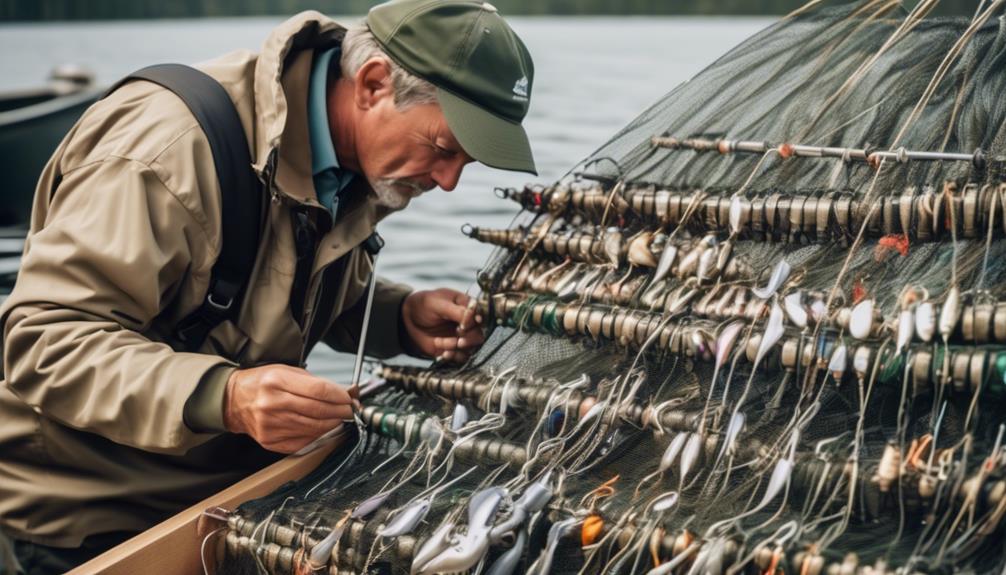
Selecting the right gear plays a crucial role in ensuring the well-being of the fish you release back into the water after a successful catch. When choosing your gear, there are ethical considerations to keep in mind to minimize harm to the fish and their environment.
Selecting the Right Gear
- Fishing Rod and Reel
- Opt for a rod and reel that matches the size of the fish you intend to catch. This ensures that you can reel in the fish efficiently without causing excessive stress or exhaustion.
- Hooks and Lures
- Use barbless hooks to minimize injury to the fish and make it easier to release them. Additionally, select lures that are designed to hook onto the fish's mouth rather than deep within their throat, reducing potential harm upon release.
Proper gear maintenance is essential for ethical catch and release practices. Regularly inspect and replace worn-out gear to prevent any malfunctions that could lead to unnecessary harm to the fish. Ensuring that your gear is in good working condition not only benefits the fish but also minimizes environmental impact. Broken or lost gear can become hazardous debris in aquatic environments, posing a threat to marine life and habitats.
Educating Other Anglers
You can promote responsible fishing and conservation by educating other anglers about the importance of ethical catch and release practices. Sharing knowledge about proper handling techniques and the impact of catch and release on fish populations is essential for promoting conservation. Engaging the fishing community in conversations about sustainable fishing practices can help spread awareness and encourage others to adopt ethical approaches to fishing.
One effective way to educate other anglers is by leading by example. When you practice responsible fishing techniques, others may take notice and become curious about the methods you're using. This presents an opportunity to engage in conversations about catch and release best practices. You can also share your knowledge through social media, blog posts, or by participating in fishing forums. By providing valuable information and insights, you can help raise awareness about the importance of ethical fishing practices.
Organizing or participating in workshops and events focused on catch and release techniques can also be a powerful way to educate other anglers. These events can provide hands-on demonstrations and discussions about the proper handling of fish, the use of barbless hooks, and the benefits of catch and release for maintaining healthy fish populations.
Frequently Asked Questions
How Can Catch and Release Techniques Vary Depending on the Type of Fish Being Caught?
When catching different types of fish, the catch and release techniques can vary based on the fish's behavior and the type of bait you use. Understanding the specific behavior of the fish you're targeting will help you adjust your approach.
Different types of bait can also attract different fish species, so it's important to consider this when practicing catch and release.
Adapting your techniques to the specific fish you're targeting will improve your success in catch and release.
Are There Any Specific Regulations or Guidelines for Catch and Release in Different Regions or Bodies of Water?
In different regions or bodies of water, specific regulations and guidelines exist for catch and release. These rules ensure the enforcement of conservation efforts and best practices for fish populations.
Research supports the development of these regulations, aiming to minimize the impact on fish and their habitats. By following these guidelines, anglers can contribute to the sustainability of fish populations and the overall health of aquatic ecosystems.
What Are Some Common Mistakes Anglers Make When Practicing Catch and Release, and How Can They Be Avoided?
When practicing catch and release, common mistakes like improper fish handling and using the wrong equipment can harm the fish and impact the environment.
To prevent this, it's essential to learn best practices for handling fish, use proper gear like barbless hooks, and always consider ethical considerations.
Are There Any Special Considerations for Catch and Release When Fishing in Different Seasons or Weather Conditions?
When fishing in different seasons, you should take seasonal considerations into account for catch and release. It's important to be mindful of the temperature, water conditions, and fish behavior during different seasons.
Weather impact can also play a role in the success of catch and release. Additionally, weather conditions such as extreme heat or cold can affect the stress levels of the fish, so being aware of these factors can help improve the effectiveness of catch and release.
How Can Anglers Ensure They Are Properly Equipped and Prepared for Catch and Release, Especially When Fishing in Remote or Challenging Environments?
When fishing in remote or challenging environments, it's crucial to ensure you're properly equipped for catch and release. Selecting the right gear and being prepared to handle the fish carefully can help minimize fish stress and increase their chances of survival.
Make sure to have the necessary tools for safe hook removal and quick release. Being well-prepared in these environments can make a significant difference in the effectiveness of catch and release practices.
Conclusion
So, next time you're out on the water, remember these six effective techniques for catch and release.
By properly handling the fish, using barbless hooks, minimizing fight time, quickly and safely removing the hook, allowing for adequate revival time, and using proper release technique, you can ensure the fish's survival.
Also, don't forget to select the right gear and educate other anglers on the importance of catch and release practices.
Happy fishing!
